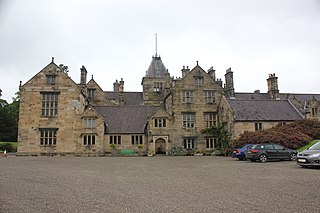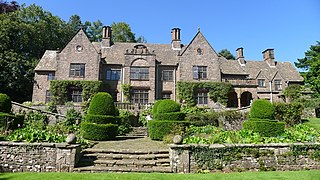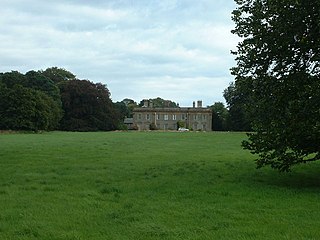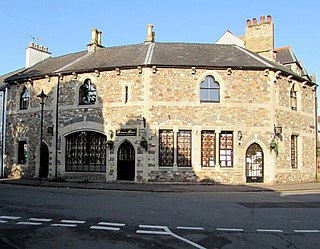
Ewenny Priory, in Ewenny in the Vale of Glamorgan, Wales, was a monastery of the Benedictine order, founded in the 12th century. The priory was unusual in having extensive military-style defences and in its state of preservation; the architectural historian John Newman described it as “the most complete and impressive Norman ecclesiastical building in Glamorgan”. Following the Dissolution of the Monasteries, parts of the priory were converted into a private house by Sir Edward Carne, a lawyer and diplomat. This Elizabethan house was demolished between 1803 and 1805 and replaced by a Georgian mansion, Ewenny Priory House. The house is still owned by the Turbervill family, descendants of Sir Edward. The priory is not open to the public apart from the Church of St Michael, the western part of the priory building, which continues to serve as the parish church for the village. The priory is in the care of Cadw and is a Grade I listed building.

Powis Castle is a medieval castle, fortress and grand country house near Welshpool, in Powys, Wales. The seat of the Herbert family, earls of Powis, the castle is known for its formal gardens and for its interiors, the former having been described as "the most important", and the latter "the most magnificent", in the country. The castle and gardens are under the care of the National Trust. Powis Castle is a Grade I listed building, while its gardens have their own Grade I listing on the Cadw/ICOMOS Register of Parks and Gardens of Special Historic Interest in Wales.

Raglan (; is a village and community in Monmouthshire, south east Wales, United Kingdom. It is located some 9 miles south-west of Monmouth, midway between Monmouth and Abergavenny on the A40 road very near to the junction with the A449 road. The fame of the village derives from Raglan Castle, built for William ap Thomas and now maintained by Cadw. The community includes the villages of Llandenny and Pen-y-clawdd. Raglan itself has a population of 1,183.

Dyffryn Gardens, also spelt Duffryn Gardens, is a collection of botanical gardens located near the villages of Dyffryn and St. Nicholas in the Vale of Glamorgan, Wales. The gardens were selected by the British Tourist Authority as one of the Top 100 gardens in the UK and are in the care of the National Trust. They are designated at Grade I, the highest grade, on the Cadw/ICOMOS Register of Parks and Gardens of Special Historic Interest in Wales.

Treberfydd House is a Gothic Revival house, built in 1847–50 just south of Llangorse Lake in the Brecon Beacons National Park in South Wales, to the designs of architect John Loughborough Pearson. It remains a private home to the Raikes family and is a Grade I listed building. The gardens are listed on the Cadw/ICOMOS Register of Parks and Gardens of Special Historic Interest in Wales.

Mostyn Hall is a large house standing in 25 acres of garden near the village of Mostyn, Flintshire, Wales. It is designated by Cadw as a Grade I listed building.

St Peter's Church is a Church of England parish church at Dixton in Wales. It is situated on the banks of the River Wye, about 1 mile (1.6 km) north-east of Monmouth, Wales. The church is a Grade II* listed building and the cross in the churchyard is both a listed building and a scheduled monument.

Mathern Palace is a Grade I listed building in the village of Mathern, Monmouthshire, Wales, located some 3 miles (4.8 km) south-west of Chepstow close to the Severn Estuary. Between about 1408 and 1705 it was the main residence of the Bishops of Llandaff. After falling into ruin, it was restored and its gardens laid out between 1894 and 1899 by the architectural writer Henry Avray Tipping. The garden surrounding the palace is listed on the Cadw/ICOMOS Register of Parks and Gardens of Special Historic Interest in Wales.

Wyndcliffe Court, 0.5 miles (0.80 km) north of the village of St. Arvans, Monmouthshire, Wales, is a Grade II* listed country house and gardens in the Arts and Crafts style, completed in 1922. The client was Charles Leigh Clay and the architect Eric Francis. The gardens were designed by Henry Avray Tipping and are included on the Cadw/ICOMOS Register of Parks and Gardens of Special Historic Interest in Wales.

There are around 1,000 listed buildings in Cardiff, the capital city of Wales. A listed building is one considered to be of special architectural, historical or cultural significance, which is protected from being demolished, extended or altered, unless special permission is granted by the relevant planning authorities. The Welsh Government makes decisions on individual cases, taking advice from the heritage agency Cadw, the Royal Commission on the Ancient and Historical Monuments of Wales and local councils.

There are 33 Grade I listed buildings in the Vale of Glamorgan all of which are churches and priory buildings, castles, country or manor houses and associated structures such as churchyard crosses and a dovecote.

Monmouthshire is a county and principal area of Wales. It borders Torfaen and Newport to the west; Herefordshire and Gloucestershire to the east; and Powys to the north. The largest town is Abergavenny, with the other major towns being Chepstow, Monmouth, and Usk. The county is 850 km2 in extent, with a population of 95,200 as of 2020. The present county was formed under the Local Government (Wales) Act 1994, which came into effect in 1996, and comprises some sixty percent of the historic county. Between 1974 and 1996, the county was known by the ancient title of Gwent, recalling the medieval Welsh kingdom. In his essay on local government in the fifth and final volume of the Gwent County History, Robert McCloy suggests that the governance of "no county in the United Kingdom in the twentieth century was so transformed as that of Monmouthshire".

In the United Kingdom, the term listed building refers to a building or other structure officially designated as being of special architectural, historical, or cultural significance; Grade II* structures are those considered to be "particularly important buildings of more than special interest". Listing was begun by a provision in the Town and Country Planning Act 1947. Once listed, strict limitations are imposed on the modifications allowed to a building's structure or fittings. In Wales, the authority for listing under the Planning Act 1990 rests with Cadw.

Moynes Court is a Grade II* listed building in the village of Mathern, Monmouthshire, Wales, about 3 miles (4.8 km) south west of Chepstow. An earlier building was rebuilt as a private residence by Francis Godwin, Bishop of Llandaff, in about 1609/10, and much of the building remains from that period. Its grounds contain earthworks thought to be the foundations of an earlier moated manor house. The gatehouse to the court has a separate Grade II* listing. The garden at the court is on the Cadw/ICOMOS Register of Parks and Gardens of Special Historic Interest in Wales.

Mounton House, Mounton, Monmouthshire, Wales, is the last major country house built in the county, constructed between 1910 and 1912 by the architect and writer Henry Avray Tipping for himself. Formerly a school, which has now relocated to the grounds, the house has been divided into apartments. It is a Grade II* listed building. The surrounding park is on the Cadw/ICOMOS Register of Parks and Gardens of Special Historic Interest in Wales.

Ffynone is a mansion and estate near Boncath, Pembrokeshire, Wales, in the parish of Manordeifi. The original Georgian design was by the architect John Nash, and the house was later remodelled by Inigo Thomas. It is a Grade I listed building, and its gardens and park are also listed, at Grade I, on the Cadw/ICOMOS Register of Parks and Gardens of Special Historic Interest in Wales.

Leeswood Hall is a country house in Leeswood, Flintshire, Wales. Dating from 1742, it was built for George Wynne, the design being attributed to Francis Smith. Construction reputedly cost £40,000. The hall is a Grade II* listed building. To the northwest of the hall stand the White Gates, which have their own Grade I listing. The gates terminate the view from the hall across the lawns, an early and rare example of 18th century parkland design by Stephen Switzer, and a Grade I listed landscape of national significance.

St Andrew, with the address of 1 High Street, is a 19th-century residential building in Llandaff, Cardiff, Wales. The building is a two-storey Grade II listed structure and it was listed because it is "Included as an unaltered design by Ewan Christian and for its group value with the other listed buildings around the Cathedral Green and on the High Street". The garden wall of St Andrew is also a Grade II structure.

19 High Street is a small mid-19th-century residential domestic building in Llandaff, Cardiff, Wales. The building is a two-storey Grade II listed structure and it was listed because it is "Included for its group value with the other listed buildings around The Cathedral Green and on the High Street".

2-4 High Street is a commercial property, currently used as a Chinese restaurant in Llandaff, Cardiff, Wales. The building is a two-storey Grade II listed structure and it was listed because it is "Included as a possible design by John Prichard and for its group value with the other listed buildings around The Cathedral Green and on the High Street". It was built of polychromatic stone and Bath stone.






















